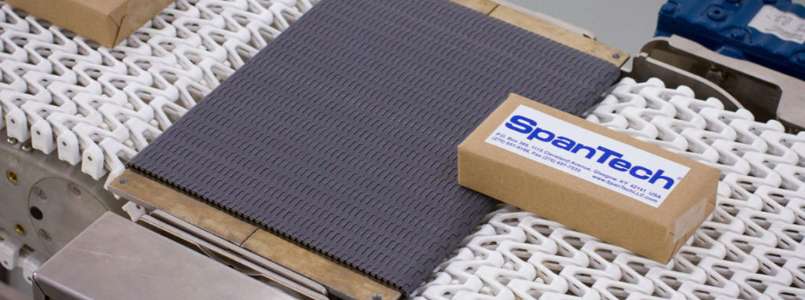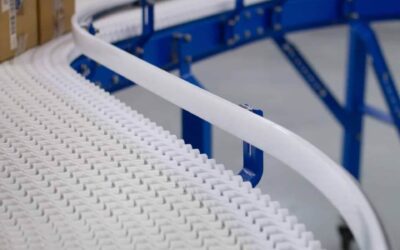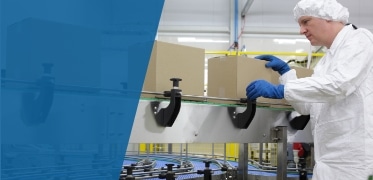What Is a Conveyor Belt System?
A conveyor belt system is a quick and efficient mechanical handling device that moves materials from one place to another. There are various types of conveyor systems, but they typically include a frame to support a set of wheels, conveyor rollers or a belt. Materials are set on top to move them from place to place. A conveyor belt may be powered manually, by gravity or, most commonly, with the help of a motor. There are many different kinds of conveyor belt systems, each tailored to execute a specific task.
Benefits of Conveyor Systems
When people move heavy items, it takes longer, costs more and increases the likelihood of personal injury. Industrial conveyor systems are faster at moving products from one place to the next. They can span multiple levels, efficiently moving items from one floor to another. And conveyor belts can unload materials automatically, eliminating the need for a person to wait at the end of the line to offload the products.

How Conveyor Belt Systems Work
In a typical conveyor belt system, a belt forms a closed loop and stretches across two or more pulleys. This enables it to rotate continually. One of the pulleys (the drive pulley) moves the items from one place to another. While traditional conveyor belt systems are straight, some units require turns to deliver the product to their destination. In these cases, cone-shaped wheels or rotors are used to enable the belt to follow a turn without tangling.
Common Conveyor System Parts
Conveyor systems have essential parts that enable them to operate properly. These parts will vary depending on the types of product being moved and how the system is being used. However, there are three main parts to every industrial conveyor system:
- Belt Support: This ensures the belt moves smoothly. The support unit must be firm; otherwise, the belt will sag when you place a heavy object on it—sagging results in slower operation and poor efficiency. Proper belt tension will keep the belt tight and the system running effectively.
- Pulley: This external component controls the belt’s movement. The working principle behind this system is that every unit has a minimum of two pulleys. One operates under power, the other is idle. Complex conveyor systems may feature more rotors along the frame.
- Drive Unit: This unit has a counter bearing to keep the parts moving effectively. It allows the belt to shift into reverse and handle the repeated changes in direction that some systems require. Manually operated conveyor systems still use a drive unit; they just don’t have a motor.
Types of Conveyors
There are many different types of conveyors, each designed to serve a particular purpose. In addition to belt and roller conveyor systems, which are the most popular, other types include:
- Slat/Apron: Steel, wood or other materials are used on plates mounted on roller chains to move the products. This type of conveyor is used for moving large, heavy materials like drums, crates or pallets in places like steel mills or foundries.
- Ball Transfer: This non-motorized method of moving products along a conveyor handles products on an assembly or packaging line or transfers products from one line to another. It may also be used in sorting systems.
- Magnetic: Using magnets located underneath stationary beds, this conveyor system is often used to move magnetic materials like machining scrap. Because they are magnetic, the conveyors can be positioned horizontally, vertically or upside down to accommodate the system’s needs.
- Bucket: This type of automated conveyor system can be used horizontally or vertically to move and deliver materials. Typical materials used with bucket conveyors include bulk products, like sludge or sand, and foods, such as grain and sugar.
- Chute/Trough: Another manual form of conveyor, a chute conveyor uses friction to move things like scrap materials and postal packages.
- Tow/Drag/Chain Conveyor: Mechanical devices are attached to cables or chains that tow or drag products in these conveyor systems. Used to move bulk items in flights, bins or other attachments, these conveyors can have multiple loading spots or discharge points.
- Overhead: Used in material handling applications that require products to be hung, this type of conveyor is mounted from ceilings with carriers or trolleys moved by cables or chains. Conveyor applications include dry-cleaning garments, parts and handling systems, paint lines or cooling and curing.
- Pneumatic/Vacuum: Air pressure or vacuum is used to move materials or items through closed ducts or tubes or along surfaces in this type of conveyor belt. Applications include dust collection, ticket delivery and paper handling. Banks use this type of system for transporting paperwork to and from drive-up stations.
- Screw/Auger: Screw conveyor systems transport foodstuffs like grains, flakes, pods, seeds and granules to be mixed, agitated or blended. They’re also used in agricultural applications in farm machinery and factories.
- Changing Elevation: The purpose of changing elevation conveyors is to transport materials between various levels of conveying lines.
- Vibrating: Dry bulk materials like gravel, aggregate and coal move along a vibrating conveyor via a tube, trough or flat tabletop.
- Walking Beam: Employing a combination of moving and static supports, walking beam conveyor systems index workpieces through manufacturing cells. Walking beams are often used on automation and assembly lines.
- Wheel conveyor: Using gravity or manual power, wheels transport products from one place to another. Wheel conveyors are commonly used in package handling, assembly lines and loading/unloading trucks.
How to Choose the Right Industrial Conveyor System
Before deciding on what type of conveyor system is right for your application, there are three major factors to consider:
- Material: This is the most crucial consideration when choosing a conveyor belt system. Think about the size, moisture content and whether the material you are moving flows or is abrasive/corrosive. Another consideration is whether the material needs to maintain a specific temperature. What is the composition of your material? Is it a powder or granule, pellet or fiber? Particle weight, density and size are also things you will need to take into account.
- Function: Is this a conveying or feeding process? Conveying is transporting materials from a pick-up point to a drop-off point. If so, you’ll need to know the number of points, the amount of material, the amount of time it should take and whether there will be a problem if cross-contamination occurs. Feeding is the more straightforward of these conveyor systems, requiring a straight pick-up to drop-off point. The product may need to be delivered in batches or at a controlled rate.
- Environment: Where is the facility located? Will you encounter high temperatures/humidity, pressure or vibrations? Are you working with fragile materials? If you use flammable or hazardous materials, potential risks and workarounds need to be assessed. The conveyor system’s size in relation to the workspace and other equipment is another consideration.
How Does a Conveyor Belt Work for Your Company? Span Tech Can Help
How does a conveyor belt work for your company? With Span Tech, it works however you need it to. Our industries archive gives you an idea of how we’ve formulated solutions for clients from many industries. We can help you boost your sorting and merging functions or create a conveyor transfer system. Maybe you need an accumulating conveyor or something completely different. Span Tech has the experience and know-how to set you up with a system geared to your company’s needs. Contact us today, and let’s talk about how we can help!











